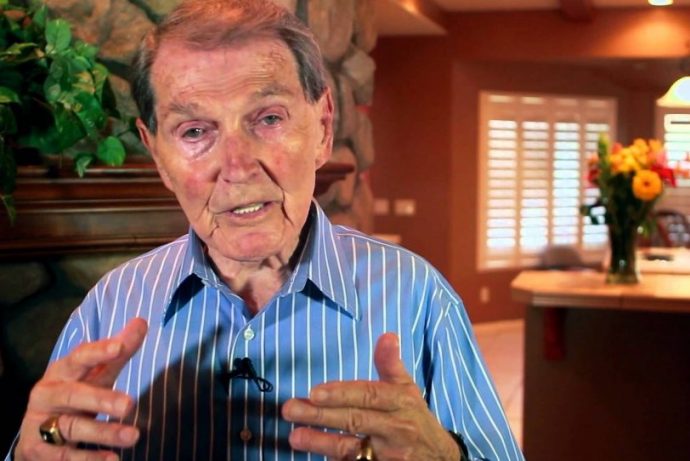The whipcrack of agon has lashed America’s 2016, and Tim LaHaye has died.
The extraordinarily influential evangelical remains best known for his co-authorship of the Left Behind novels, ubiquitous between the Clinton and Bush administrations. But LaHaye not only lived through several different Americas in his 90 years, he helped shape our present moment. On the face of it, this seems an obvious, water-is-wet-ish thing to say about a public figure. But LaHaye did more than simply contribute to public discourse, or propose a particular religious perspective; he help facilitate a way of seeing the world, of being in the world, that will long outlive him.
LaHaye’s death has already been met with wave upon wave of opinion pieces pointing to his body as evidence of—no really, it’s definitely going to happen this time—the death of the Christian Right, or the decline of the aging white male conservative. Whether or not that comes to be (and while everyone knows where the demographics have long been pointing, I have my doubts about the conceptual change we are told will accompany this shift), LaHaye’s style of seeing a particular reality into being is going nowhere, precisely because the conditions they had a part in shaping seem so final, so unshakable.
It is also difficult to avoid appraising LaHaye’s public life outside those many proclamations that Donald Trump is the candidate America deserves, or that his Tweet-storm rallies marry 1980s Gecko greed with old-school doomsaying. In this, people say on their social media or pundits in their columns and airtime, Trump is the natural outgrowth of disaffected post-working class isolationism combined with Reagan-era economics.
Those characterizations might be partly true but they fail to capture some of the more lasting features of this America, an America whose several discreditings and multiform rage has left all watching scrambling to find an account of things that would make sense of institutional racism, gunplay, Islamophobia, Bernie Bros, email scandals, and whatever is coming next. But that notion, the firm belief that an unseen yet deeply felt cataclysm—or, in Trump’s phrasing, “there’s something going on”—is precisely what has become standard political fare in recent decades, building on earlier iterations of the apocalyptic and the conspiratorial to become the mundane.
I am not claiming that the things LaHaye built and did and wrote have had some kind of causal role in any of the actual events swirling in this agonistic America. But we live in Tim LaHaye’s world.
The facts of his life are well-known. Detroit-born, WWII vet, Bob Jones grad, LaHaye ultimately emerged from the finishing school of far-right Cali politics in the early 1960s, populated by rocket scientists, Goldwater anti-feds, Birchers, and conspiracy wonks.
In a land of almost alien brightness, LaHaye was a kind of first responder to a series of Supreme Court decisions—most obviously Engel v. Vitale and Abington School District v. Schempp, although Randall Balmer and others have insisted that the lingering disorientation of Brown and desegregation cannot be ignored—that reshaped American education (for the worse, according to LaHaye and many others). He established first a separate school, then a separate school system, then colleges and other institutions, in the process proving himself to be an architect of curriculum debates that would shape the 1970s and 1980s.
LaHaye’s educational philosophy was, structurally and politically, a kind of linchpin for how he thought about social and political issues more broadly: the world was a giant slippery slope, or (if we are to see him as anticipating something of the mad foment of competing outrages and conspiracies that is our everyday politics now) a giant hyperlink authored by shadowy elites.
It is simple enough to see in his institutional efforts—the Institute for Creation Science, the Council for National Policy, the American Coalition for Traditional Values, and his material and conceptual support for Beverly LaHaye’s Concerned Women for America—tangible evidence of the widely known role of New Christian Right organizations in the rise of neoconservatism and recrudescence of populism in the 1970s and thereafter. And it is also appropriate to see in his voluminous writings—from his influential “Battle” trilogy to the mega-sellers co-authored with Jerry B. Jenkins—a series of critical templates whose resonance has yet to abate.
But it is not enough to enumerate items on LaHaye’s vita.
When I first wrote about LaHaye, I said of him (and other Christian critics of political order) that, regardless of policy and theological particulars, we might at least see a kind of civic engagement in, for example, LaHaye’s criticisms of public education. That remains true, of course, but it is too limited a perspective. What he should more aptly be remembered for—and regardless of however loving his relationships might have been, however “sincere” or “authentic” the scholar of religion might (tiresomely) insist his contributions were—is a steadfast, decades-long turning from considerations fundamental to rethinking of the terms of American democracy (and the role of religion therein) and a championing of the technologies of our imagination in fantastical visions of disorder.
This way of seeing things—threnody, conspiracy, and furious thou-shalt-not all blended—is what shaped LaHaye’s decades-long endorsement of institutional detachment, his insistence on claiming and absorbing the lives of others into a singular narrative. Unlike those figures whose influence came primarily through their public address, LaHaye tilled the ground, made roads out of the schools, out of the New Deal, and quite frankly out of the commons, no matter how often he lobbied or shook hands with the powerful.
Despite how obvious it is that the emptied coffers after Vietnam, the disastrous slashing of the social safety net in the 1980s, the protracted legitimation crisis in American democracy, and the failure attend to the still crippling forces of racism, inequality, and political apathy are the big stories in this America, LaHaye’s fact-fictional writing constituted a kind of archive deflecting attention from these issues, instead giving his readers and sympathizers an escape route.
It cannot be enough, LaHaye insisted directly and obliquely, that Americans might benefit by rethinking what our expectations are for political representation, for the role of protest in mass participation, or for entitlement and desert. There must be something going on besides the unexciting grind of proceduralism and incremental change, besides the hard work of learning how to listen and talk to each other freshly. Surely our lives must be more thrilling than that, right?
Our world, LaHaye’s world, affirms the outsized importance of our answers to just that question.





